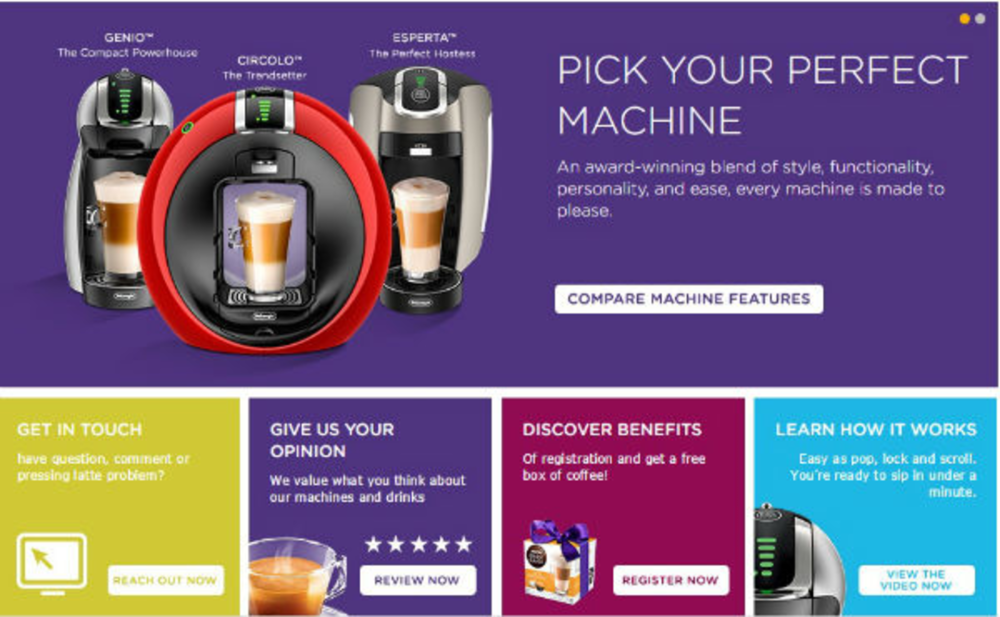Nestlé UK and Ireland wants to convert nations of coffee drinkers into buyers of the Dolce Gusto capsule brewing system. So, the company has added a high-performance programmatic campaign to the marketing mix. The early results from the peak holiday 2014 season were encouraging, with over 90% of ads reaching the precisely targeted audience, and with higher-than-expected results for viewability and brand safety.
The programmatic campaign is designed to reach targeted consumers at a variety of online destinations. “The customer journey today is a continuum, and programmatic breaks out of the media funnel,” says James Bourner, head of display at Jellyfish, which serves as agency for the campaign. “We can put an advert when and where [a consumer] needs to see it, as opposed to hoping they conform to how we would traditionally structure a campaign.”
Nestlé UK and Ireland researched programmatic campaigns as early as September 2013 and used small trials over the ensuing 12 months to test the effectiveness. “Up to that point we were buying digital media in the standard format. We knew who our audience was and we advertised on individual websites,” says Gawain Owen, digital lead, Nestlé UK and Ireland. “But we couldn’t optimize viewability and it was hard to optimize to the audience. It was just a site buy.”
Dolce Gusto was a particular appealing product line for an initial foray into full-scale programmatic. The majority of units are sold in the fourth quarter. Most purchases are through retail and online channels, not direct from the brand site. This amplifies the importance of reaching the right customers at the right time, and for making effective media buys during the holiday season against substantial competition from other advertisers. “By October 2014 the stars had very much aligned: the inventory was available, we were very comfortable with our agency partner, and we had the technology to make it possible,” Owen says.
Owen’s organization was careful to define metrics for the campaign and establish parameters for success. The campaign was geared to reach an audience representing specifically targeted demographics who had never been to the brand website. He wanted to be sure that viewable impressions were tracked, according to standards defined by the Interactive Advertising Bureau (IAB). Viewability standards vary by media type, but one reference mark is that a minimum of 50% of a display ad’s pixels need to be in the consumer’s view for at least one second.
The programmatic algorithm targeted multiple consumer groups, including those that Nestlé UK and Ireland refers to as “Sociable Sharers” (consumers in their 20s to mid-30s who are very active online discussing and promoting their own lifestyle choices and purchases) and “Busy Achievers” (married and cohabitating couples with successful career paths, and in some cases young and growing families). Using pixel tags, the company attempted to deliver ads to only those consumers who had not already visited the Dolce Gusto brand site.
Owen also wanted to keep the blocking rate—the frequency of ads that could not be delivered because they wouldn’t adhere to brand safety standards—to a minimum. For example, a story on violent crime on an otherwise whitelisted news site would be considered brand unsafe. Jellyfish and Nestlé UK and Ireland were able to cut the blocking rate to just 1%, far below the 7% they identify as an industry average. (This blocking is enforced by the campaign’s ad verification tools, and should not be confused with in-browser ad-blocking tools.)
Viewable impressions beat the IAB reference standards by a comfortable margin. Overall, 91% of ad impressions for the 2014 programmatic campaigns reached the desired market of new consumers.
An integrated approach
Nestlé UK and Ireland’s embrace of programmatic was as much about delivery technology as it was the arrival of premium inventory on the market. For the first time Owen had access to branded skins and front-page takeovers at key consumer destinations, including eBay, in programmatic fashion. “We saw fantastic click-through and engagement rates on our website,” he says. “Contextually, the eBay audience was absolutely spot on, which is why we ran eBay campaigns twice within a 14-day span. You don’t continue something in programmatic if it’s not successful.”
A key element of programmatic campaigns is the ability to synchronize multiple media placements. During these campaigns Dolce Gusto also increased paid search campaigns to generate peak placement for relevant terms within five to 10 minutes of every premium TV spot in its markets.
To close the loop with completed purchases, Nestlé UK and Ireland integrated CRM data with offline sales using an old-fashioned conversion signal: a gift certificate included in every Dolce Gusto box. When claimed, the company can attribute the purchase and sync consumer data. This not only identifies new customers, but also helps Nestlé UK and Ireland understand which regions are outperforming and further optimize media buys to those territories.
Programmatic campaigns still require a careful balance of automated expertise and hands-on ingenuity, and the right combination was on hand for the successful Dolce Gusto effort. “We’re confident in the technology, as well as the ability of the human beings involved in programmatic,” Owen says. “We no longer have to buy one million impressions and hope the audience shows up. Now we engage with consumers around the rather big World Wide Web and communicate through a variety of brand-safe publishers.”








